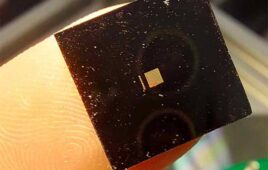
Organ Chips, like this Kidney Chip, consist of clear upper and lower components through which run parallel channels (red and blue) separated by a semipermeable membrane. The upper component’s channel is seeded with the cells of a given organ type, while the lower component’s channel is seeded with endothelial cells to mimic blood vessels. [Image from Harvard University]
The new protocol combines multi-scale patterning of organ chip parts into a single step, which in turn saves time, improves reproducibility and traceability and reduces the risk of contamination.
“We hope this new protocol will enable researchers in labs around the world to create organ chips more easily and quickly, helping to drive future advances in drug discovery and development as well as personalized medicine,” Richard Novak, the study’s first author and a senior staff engineer at the Wyss Institute at Harvard, said in a press release.
Organs-on-chips have enabled scientists to study the physiology of human organs in a lifelike environment in vitro and have replicated organ activities and disease states in vivo. Organs-on-chips have allowed scientists to develop drugs and study biological mechanisms without having to use animals or humans to test different drugs. However, one of the challenges of organs-on-chips is that large numbers are needed for biological studies and can be harder to manufacture in labs that lack specialized equipment, which limits their use in research.
Harvard University researchers made chips using a new protocol. The chips featured three components made from a clear silicone rubber polymer. It had a top channel, a bottom channel on a microscopic slide and a porous membrane between the two channels. All of the channels are seeded with organ cells or blood vessel cells when they are assembled. The membrane allows for molecules to exchange between the two layers.
The researchers say some parts of the protocol are harder to automate. However, it still enables the production of dozens of chips a week by one researcher with higher accuracy and less hands-on time than other organ-on-chip protocols.
“Organ chips provide a way for researchers to gain insight into human biology at the cell, tissue and organ levels without the need for harming humans or animals. We hope that this new protocol will allow more labs to enter this field and explore entirely new research paths using this technology,” said Donal Ingber, one of the researchers on the project and the Wyss Institute’s founding director.
The research was published in the Journal of Visual Experiments and was supported by DARPA, the FDA, National Institutes of Health and the Bill and Melinda Gates Foundation.




